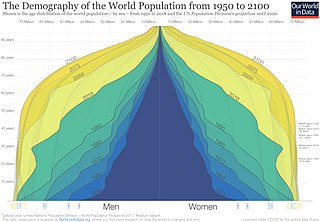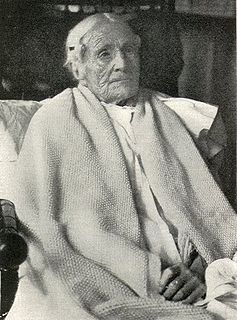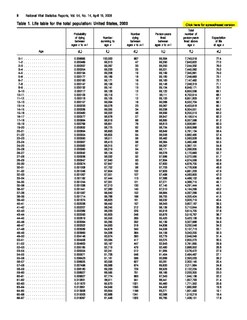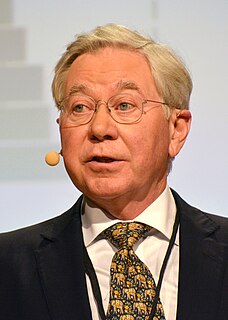
Life expectancy is a statistical measure of the average time an organism is expected to live, based on the year of its birth, its current age, and other demographic factors like sex. The most commonly used measure is life expectancy at birth (LEB), which can be defined in two ways. Cohort LEB is the mean length of life of a birth cohort and can be computed only for cohorts born so long ago that all their members have died. Period LEB is the mean length of life of a hypothetical cohort assumed to be exposed, from birth through death, to the mortality rates observed at a given year.

Demography is the statistical study of populations, especially human beings.

Senescence or biologicalaging is the gradual deterioration of functional characteristics in living organisms. The word senescence can refer to either cellular senescence or to senescence of the whole organism. Organismal senescence involves an increase in death rates and/or a decrease in fecundity with increasing age, at least in the latter part of an organism's life cycle.

Mortality rate, or death rate, is a measure of the number of deaths in a particular population, scaled to the size of that population, per unit of time. Mortality rate is typically expressed in units of deaths per 1,000 individuals per year; thus, a mortality rate of 9.5 in a population of 1,000 would mean 9.5 deaths per year in that entire population, or 0.95% out of the total. It is distinct from "morbidity", which is either the prevalence or incidence of a disease, and also from the incidence rate.

The word "longevity" is sometimes used as a synonym for "life expectancy" in demography. However, the term longevity is sometimes meant to refer only to especially long-lived members of a population, whereas life expectancy is always defined statistically as the average number of years remaining at a given age. For example, a population's life expectancy at birth is the same as the average age at death for all people born in the same year. Longevity is best thought of as a term for general audiences meaning 'typical length of life' and specific statistical definitions should be clarified when necessary.
Maximum life span is a measure of the maximum amount of time one or more members of a population have been observed to survive between birth and death. The term can also denote an estimate of the maximum amount of time that a member of a given species could survive between birth and death, provided circumstances that are optimal to that member's longevity.

In actuarial science and demography, a life table is a table which shows, for each age, what the probability is that a person of that age will die before their next birthday. In other words, it represents the survivorship of people from a certain population. They can also be explained as a long-term mathematical way to measure a population's longevity. Tables have been created by demographers including Graunt, Reed and Merrell, Keyfitz, and Greville.
Longevity claims are unsubstantiated cases of asserted human longevity. Those asserting lifespans of 110 years or more are referred to as supercentenarians. Many have either no official verification or are backed only by partial evidence. Cases where longevity has been fully verified, according to modern standards of longevity research, are reflected in an established list of supercentenarians based on the work of organizations such as the Gerontology Research Group (GRG) or Guinness World Records. This article lists living claims greater than that of the oldest living person whose age has been independently verified, French woman Lucile Randon, at 118 years, 145 days, and deceased claims greater than that of the oldest person ever whose age has been verified, namely her compatriot Jeanne Calment, who died at the age of 122 years and 164 days. The upper limit for both lists is 130 years.
The Gompertz curve or Gompertz function is a type of mathematical model for a time series, named after Benjamin Gompertz (1779–1865). It is a sigmoid function which describes growth as being slowest at the start and end of a given time period. The right-hand or future value asymptote of the function is approached much more gradually by the curve than the left-hand or lower valued asymptote. This is in contrast to the simple logistic function in which both asymptotes are approached by the curve symmetrically. It is a special case of the generalised logistic function. The function was originally designed to describe human mortality, but since has been modified to be applied in biology, with regard to detailing populations.
Biodemography is a multidisciplinary approach, integrating biological knowledge with demographic research on human longevity and survival. Biodemographic studies are important for understanding the driving forces of the current longevity revolution, forecasting the future of human longevity, and identification of new strategies for further increase in healthy and productive life span.
The reliability theory of aging is an attempt to apply the principles of reliability theory to create a mathematical model of senescence. The theory was published in Russian by Leonid A. Gavrilov and Natalia S. Gavrilova as Biologiia prodolzhitelʹnosti zhizni in 1986, and in English translation as The Biology of Life Span: A Quantitative Approach in 1991.
The compensation law of mortality states that the relative differences in death rates between different populations of the same biological species decrease with age, because the higher initial death rates in disadvantaged populations are compensated by lower pace of mortality increase with age. The age at which this imaginary (extrapolated) convergence of mortality trajectories takes place is named the "species-specific life span". For human beings, this human species-specific life span is close to 95 years.

The Gompertz–Makeham law states that the human death rate is the sum of an age-dependent component, which increases exponentially with age and an age-independent component. In a protected environment where external causes of death are rare, the age-independent mortality component is often negligible. In this case the formula simplifies to a Gompertz law of mortality. In 1825, Benjamin Gompertz proposed an exponential increase in death rates with age.
Advanced maternal age, in a broad sense, is the instance of a woman being of an older age at a stage of reproduction, although there are various definitions of specific age and stage of reproduction. The variability in definitions is in part explained by the effects of increasing age occurring as a continuum rather than as a threshold effect.
Enquiry into the evolution of ageing, or aging, aims to explain why a detrimental process such as ageing would evolve, and why there is so much variability in the lifespans of organisms. The classical theories of evolution suggest that environmental factors, such as predation, accidents, disease, starvation, ensure that most organisms living in natural settings will not live until old age, and so there will be very little pressure to conserve genetic changes that increase longevity. Natural selection will instead strongly favor genes which ensure early maturation and rapid reproduction, and the selection for genetic traits which promote molecular and cellular self-maintenance will decline with age for most organisms.
Following is a list of topics related to life extension:
Biodemography is the science dealing with the integration of biological theory and demography.

James W. Vaupel was an American scientist in the fields of aging research, biodemography, and formal demography. He was instrumental in developing and advancing the idea of the plasticity of longevity, and pioneered research on the heterogeneity of mortality risks and on the deceleration of death rates at the highest ages.

Negligible senescence is a term coined by biogerontologist Caleb Finch to denote organisms that do not exhibit evidence of biological aging (senescence), such as measurable reductions in their reproductive capability, measurable functional decline, or rising death rates with age. There are many species where scientists have seen no increase in mortality after maturity. This may mean that the lifespan of the organism is so long that researchers' subjects have not yet lived up to the time when a measure of the species' longevity can be made. Turtles, for example, were once thought to lack senescence, but more extensive observations have found evidence of decreasing fitness with age.

The mutation accumulation theory of ageing was first proposed by Peter Medawar in 1952 as an evolutionary explanation for biological ageing and the associated decline in fitness that accompanies it. Medawar used the term 'senescence' to refer to this process. The theory explains that, in the case where harmful mutations are only expressed later in life, when reproduction has ceased and future survival is increasingly unlikely, then these mutations are likely to be unknowingly passed on to future generations. In this situation the force of natural selection will be weak, and so insufficient to consistently eliminate these mutations. Medawar posited that over time these mutations would accumulate due to genetic drift and lead to the evolution of what is now referred to as ageing.










